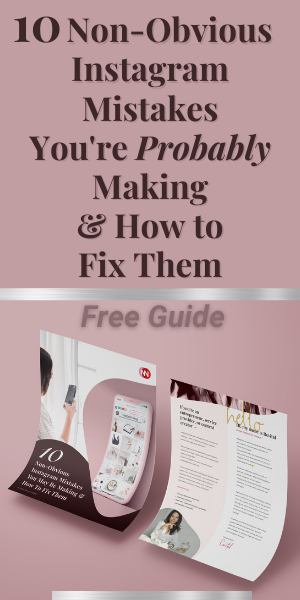Should you share content for free? How much of your content should be free content? What kind of content should you share? Where should you share it?
If you're an online business owner, a digital content creator, or someone offering their services online, you've probably debated these questions at one point or another.
Free
content means sharing valuable content with your audience without them having
to pay. It doesn't mean you
will not be making money on it!
Now that so many are promoting personal brands, online courses, information, and knowledge, the questions of free content monetization, and drawing a line between free and paid content, are relevant more than ever before.
Your goal is to grow your business.
Free content is an organic way to increase traffic and the strategies you can use to attract your relevant audience is endless:
Blog posts, YouTube videos, educational material, social media posts, surveys, infographics, quotes, polls, podcasts, reviews, and recommendations, are only some of the examples out there.
Well, in this blog post, we are going to show you, for free:), what is the purpose of sharing free content, and how you can monetize even free content to help you make money as a business owner or digital content creator from the very beginning.

What is
Content Marketing?
Content marketing is a marketing strategy that focuses on creating valuable, relevant, and consistent content to attract an audience and to drive profitable customer action.
YES! All Of The Reasons Why You Should Be Sharing Content For Free
- Build Trust with Your Audience – Once you build trust, it will feel effortless to share recommendations because your main goal would be to help others.
Having an audience that trusts you and your brand is the most important thing to aim for as a business owner or content creator.
- Attract Ideal Customers – When you write about topics within your business niche and include content that your ideal customers may be looking for, that's how you can help your audience find you. Users may not be familiar with your brand but may discover you when searching for good quality advice that you share.
- Build Brand Awareness – It is not easy to build brand awareness, especially in the B2C market. Content marketing may feel like a strategy that isn't directly correlated to sales. Still, by consistently increasing quality traffic to your business, you build brand awareness and at the same time attract potential clients (i.e., leads) who might one day turn to customers.
- Improve your SEO – Creating valuable, high-quality content for your target audience is usually appreciated also by Google's algorithm. How? When your content provides the answer to people's searches - this means your website, your brand, will rank higher on Google search. In other words, your visibility on search engines and across social media and will reach your prospective buyers more effectively.
NO! All of The Reasons Why You Should Not Share Content for Free
- It is demanding and time-consuming; therefore, think of it strategically as part of your monetization plan – Creating good, high-quality, valuable content isn't easy. If you want to attract customers to your business through content marketing, you better have something that cannot be found anywhere else. Quality content requires planning, researching, and finding a unique perspective that will give it a superior edge. For all these reasons, it is essential not to create content just for its sake but rather to make it part of your overall monetization plan.
- It takes a while to see results; therefore, the earlier you integrate monetization strategies, the better – As mentioned before, you won't see a massive change with content marketing overnight. Give it time, at least a few months, which is why you better start early and treat it as an investment in the future. Evergreen content planning can create a stream of passive income for years ahead. Free for your audience means they don't need to pay for it, but it doesn't mean you don't get to generate income, so consider using one of the ways explained below for monetizing free content.
- Content Marketing Isn't For Everyone – For all of the above reasons, it's ok to decide not to invest your time in content marketing and look for alternatives. Content creation is not only blog posts. It also includes pictures, podcasts, videos, even e-commerce suggestions - anything which can last for long and help you build brand awareness and authority. All you need is a desire to write and create new ideas and content.

How Does
Content Marketing Help You Grow Your Business?
Eventually, content marketing should be a driver for business growth. As impressive as can be, writing random content with no correlation to a customer's journey in mind will not help you reach your business goals.
Here are a few ideas for implementation:
- Building Trust With Your Audience Through Content Marketing – When you give your audience free and valuable information, such as helpful, educational, inspirational, or entertaining content, they grow to learn more about you. That's how you can establish trustworthiness and a positive brand reputation.
- Good Content Means More Conversions – Content marketing is THE way to increase conversions and increase your business sales. Quality, highly targeted content will generate far greater numbers.
Research shows that content marketing drives 5X more leads and is 13X more likely to generate sales.
Also, research showed that 61% of online consumers in the U.S. decided to purchase after reading recommendations on a blog or a YouTube video.
- Creating Valuable Content is a Cost-Effective Way to Bring in New Leads - Content needs to resonate with your prospects and provide a positive user experience – to add value.
By creating great content for your business through blog posts, YouTube videos, and social media posts, you drive traffic to your website and increase leads.
In fact, content marketing costs about 62% less than traditional marketing strategies and generates about three times as many leads, according to DemandMetric.If you want to maximize your marketing budget (no matter your business size), content marketing is the cheapest and most rewarding marketing strategy.
In case you need quick results for a specific project, you better use other digital marketing strategies because content marketing isn't a strategy that will make you see insane results the next day. It is time-intensive and requires a longer time horizon.

How to
Build a Content Marketing Plan?
You've decided that you are into content marketing, and you think it's a good step for growing your business. That's great!
But you are probably thinking, how do I start? Where do I start? What do I do?
Here are 10 steps for building a content marketing plan for your business:
- 1. Set Your Goals – Think about your business goals. By establishing business goals and developing your mission, you'll get a clearer vision of what to focus on and what's essential to grow your business and achieve your goals.
- 2. Know Your Audience – A successful content marketing strategy includes knowing who your audience is. Once you know that, you'll also know what content to create, which platforms to use, and how.
- 3. Assess Your Current Position – This means that you need to figure out whether the content you are planning on making will help you achieve your business goals. This step is one to think about even if you already have some content out there.
- 4. Figure Out the Best Content Channels –Once you know who your target audience is and your current audience, you'll need to dig in and do some research to learn where they are hanging. If it's on Instagram, blogs, Pinterest, YouTube, or TikTok.
- 5. Establish Your KPIs– If you want to achieve your business goals, make sure your goals are as specific as can be, so you'll know where to focus on during your journey. What you need to do, is to set key performance indicators (KPI) for your content marketing strategy.
- 6. Decide on Content Types – Now, it's time to think about the content you want to create. The most successful content marketing strategies rely on having a central core of content published, which means having a website with blog posts that you can use to promote on other social media platforms.
- 7. Create a Content Calendar – A content calendar is a must-have for your content marketing strategy, so you know when to publish each piece on which platform.
- 8. Create Content – Now comes the creative part of it all - creating content. The prep work in your content marketing strategy is essential.
- 9. Distribute and Market – Next in your content marketing strategy is distribution and marketing. Don't forget to schedule for sharing your content on social media right after you published your post.
- 10. Measure Results – Last, and finally, is time to measure results and see your content marketing strategy's success.
To do it, go back to the KPIs you set before and see what changed, what didn't, what goals you have achieved, and where there's still work to do.

Why do
You need to Monetize Your Content?
Now that we know that creating free valuable content for your audience is a great way to grow your business and increase conversions, there are 2 questions to think about:
- 1. How much of your content should be free?
- 2. What if you don’t have a product to sell?
- Attract more traffic to your business through the free content you create.
- Build your email list by offering free opt-in options through which readers can join your mailing list.
- Convert better by building a connection but also by diversifying your income streams.
How to Monetize Your Free Content?
- 1. Display Ads – Once you get a fair amount of traffic, you can expect to make a nice income from displaying ads on your website. That is if you have a blog or a website. You can join Google Adsense, Ezoic, Mediavine, and more.
- 2. Affiliate Marketing – Affiliate marketing is one of the most popular ways to make money online.
If you are new to affiliate marketing, to help you along, we have created a free "Affiliate Marketing Strategy Cheat Sheet” according to which you can build your "Affiliate Marketing Strategy Map.”
GRAB OUR FREE AFFILIATE MARKETING STRATEGY CHEAT SHEET AND BUILD YOUR AFFILIATE MARKETING STRATEGY MAP
- 3. Subscriptions – Another way to monetize your free content is by offering subscriptions. It can be a monthly recurring subscription in the form of a monthly membership or periodic.
- 4. Sponsorships – This income source is a good fit for influencers and content creators.
- 5. Sell Merchandise – This option is better for influencers/content creators with a large audience.
- 6. Sales Funnels – Free content is one of the best ways to build a process for building rapport and long-term relationships. When you treat your free content as the first step within a complete system, it is not really free—craft a full customer journey to help you monetize as you grow.
- 7. Include E-commerce recommendations in your Content – E-commerce recommendations is a free, helpful, and valuable information for your community, especially if it is based on your professional knowledge as an expert in your field.
The advantage of using e-commerce recommendations is meeting your audience's needs at any stage of their customer journey. It can be the first step for building a longer-term connection, by merely answering the pain-point they have at a certain point in time.

Where Can you Promote Your Free Content?
No matter how good your content is, what's the point if no one reads it? So, part of content marketing is actually promoting it.
Some say that you should spend at least 50% (to 80%) of your time promoting content.
The first thing to keep in mind is that you need to focus on platforms that you know your audience is when you promote your newly published content.
After knowing who your target audience is and where they are, you'll need to promote your content on those platforms.
Ways to Promote Your Content:
- 1. Posting on Social Media – One of the best ways to promote your new content is by sharing it on social media!
If your audience is on Instagram, be active on the platform, and notify your followers every time there is a new blog post/something new!
If your audience is on Pinterest, create a Pinterest account and get into Pinterest marketing. Create pins for your content, and promote your brand/free content/social media accounts on Pinterest.
- 2. Email Marketing – having an email list is essential that every business owner/content creator/blogger/service provider should have. It's the best way to build a relationship with your audience, build trust, and connect with them on a personal level.
- 3. Google SEO –SEO means Search Engine Optimization, which means ranking high on Google search and driving high-quality organic traffic to your website.
- 4. Collaborating with Influencers/Guest Posting – This is a great way to attract new readers and new potential customers to your business. All you need to do is collaborate with influencers in your niche on social media or exchange guest posts.
- 5. Paid Promotion – Running ads on social media platforms/YouTube/Google is another way to drive traffic to your website or business. If you want to see good results, it won't be cheap, but it is a way to get more eyeballs.
These days advertising has become a popular way to attract new potential customers to businesses online. You can promote your business/content through Facebook Ads, on Instagram, TikTok, YouTube, Pinterest Ads, and even on Google!
The Importance of Planning Your Content Schedule
Planning your content schedule is one of the most important things you should focus on as a content creator while using content marketing for your business.
When writing and creating content, focus on:
- What's "trending"?
- What holidays are coming up (Christmas/Easter/Hanukkah)?
- Seasonal events (back to school, summer vacations, fashion week).
Build your content according to that to reach more people and drive much more traffic to your website.
You should create content, in general, that people are looking for. Doing so can simplify audience reach and drive targeted traffic to your website and brand, making it easier to convert!









You can choose to comment as a guest.